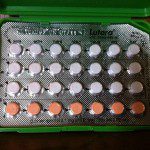This CNN article reports that the teen birth rate dropped 40% from 2009 to 2013, and 75% of this drop is due to a program that provided free IUDs.
Here’s a link from theothermccain.com which describes the program and includes a link to documentation on the program itself and the abstract of the study which detailed the outcomes of the program. Unfortunately, the study itself is behind a paywall, so it’s not possible to assess the credibility of their methodology, but here are their claims:
METHODS: Beginning in 2009, 28 Title X–funded agencies in Colorado received private funding to support CFPI. Caseloads and clients’ LARC use were assessed over the following two years. Fertility rates among low-income women aged 15–24 were compared with expected trends. Abortion rates and births among high-risk women were tracked, and the numbers of infants receiving services through the Special Supplemental Nutrition Program for Women, Infants and Children (WIC) were examined.
RESULTS: By 2011, caseloads had increased by 23%, and LARC use among 15–24-year-olds had grown from 5% to 19%. Cumulatively, one in 15 young, low-income women had received a LARC method, up from one in 170 in 2008. Compared with expected fertility rates in 2011, observed rates were 29% lower among low-income 15–19-year-olds and 14% lower among similar 20–24-year-olds. In CFPI counties, the proportion of births that were high-risk declined by 24% between 2009 and 2011; abortion rates fell 34% and 18%, respectively, among women aged 15–19 and 20–24. Statewide, infant enrollment in WIC declined 23% between 2010 and 2013.
CONCLUSIONS: Programs that increase LARC use among young, low-income women may contribute to declines in fertility rates, abortion rates and births among high-risk women.
The program itself provided, via an anonymous donor, funds to cover the full cost of “long-acting reversible contraceptives,” that is, IUDs and implants, as well as vasectomies and tubal ligations, when done at Title X clinics.
The clinics themselves are clinics which ordinarily charge income-based sliding-scale fees for uninsured patients, with subsidies from the federal government. Unlike other types of healthcare, minors are able to obtain family planning services without parental consent or notification, and, in order to preserve confidentiality, they are effectively given free services so as to not require that their parents be notified, to submit information on family income or insurance.
In participating in this program, the clinics keep the funds from the donor, and they make the discretionary decision about whether to continue to charge the sliding-scale fee, or use the fees that they collect from patients to increase their stock (that is, as seed money for after this temporary program ends). The clinic also gets to charge a 10% administrative fee.
Hence, a minor girl would not see any difference in cost, and an adult would, if the clinic chose, be presented with a regular reduced-fees for most forms of contraception, but free long-acting/permanent methods.
And this is where I’d like to see the details:
Caseloads had increased by 23%, and LARC use had increased from 5% to 19%. There’s no financial incentive for a minor to choose a LARC, but a major financial incentive for the clinic itself. Did they actively recruit women who weren’t ordinarily patients there, with a more aggressive outreach than in the past?
The headline claim at CNN is that teen births dropped by 40%, and 75% of the drop is attributed to this program. That doesn’t really seem credible, given the statements from the abstract that low-income teen births dropped by only 29% (and it’s not clear whether this refers to all low-income teen births statewide, or only those teens who were Title X clinic patients or another subgroup) – unless this is the simplistic math that 29% / 40% is approximately 75% and unless births to non-poor teenagers are negligible.
In any event, is it the right thing to do, to create a program that funnels teenage girls onto IUDs and implants? I know there are people who would propose “mandatory contraception until you prove you’d be a fit mother,” but this worries me. “Teenagers are going to have sex anyway so let’s contracept them all” is a self-fulfilling prophesy. This seems like a pretty good recipe for unintended consequences.
And here’s something odd: the IUD is less effective for teenagers than adults – with failure rates of 1.8% or 3.6%, depending on type — and teens are more likely than adults to experience side effects. With respect to the implant, I couldn’t readily find any information on whether its side effects are more of an issue for teens — though I expect that in both cases, teenagers given these devices are less able to take charge of their health and make a change due to side effects, and more susceptible to pressure from the clinician.











